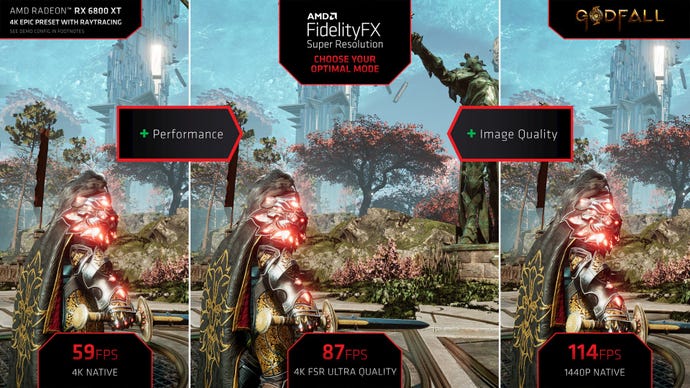AMD's DLSS rival is out, but only 7 games support it right now
AMD's FSR tech should provide a decent performance boost, even with Nvidia GPUs
Nvidia’s DLSS tech is no longer the lone performance-boosting GPU magic out there. AMD’s FidelityFX Super Resolution (also known as FSR for short) has just been released, adding the resolution-enhancing frames spurter to seven games, with more to come later in the year. If you’re struggling for frame rates in Godfall, for example, you can now boost performance with a minimal hit to the visuals, and AMD claim you could more than double your frame rate across a number of its other supported games at 4K.
If you have any of these games, you can try out FSR right now. Go on, you know you want to.
- 22 Racing Series
- Anno 1800
- Evil Genius 2
- Godfall
- Kingshunt
- Terminator: Resistance
- The Riftbreaker
Later in the year, the likes of Dota 2, Far Cry 6 and Resident Evil Village are guaranteed to have FSR, and other upcoming games on AMD's website include Baldur's Gate 3, Farming Simulator 22, Edge Of Eternity and upcoming Squeenix game, Forspoken.
Plus, every games developer will soon have access to it, according to AMD: “AMD FSR is expected to be broadly available to game developers in mid-July 2021 as a free download on AMD GPUOpen, the open-source community that provides code, documentation and resources to help developers get the most out of programming on GPUs.”

AMD’s take on the tech, where the game is rendered at a low resolution to run at a high frame rate and then upscaled to appear at a much higher resolution, has some interesting differences to Nvidia’s DLSS tech. For starters, it’s supported across a number of GPUs and CPUs. RX 5000 GPUs, RX 500 GPUs, RX Vega GPUs, and every AMD Ryzen G-Series processor with integrated Radeon graphics will be able to use it, and the Nvidia GTX-10 series, too. Not even Nvidia's own DLSS supports its olders cards, with it limited to the RTX platform. You’re less likely to struggle for hardware compatibility, which is especially pleasing in the current hardware drought.
FSR also uses spatial upscaling technology rather than anything AI-based like DLSS, using an "advanced edge reconstruction algorithm" to recreate the source image at a higher resolution while also sharpening it to improve picture quality and get it as close to native-looking as possible. The result, according to AMD, is "an image with super high-quality edges and distinctive pixel detail when compared to basic upscaling methods."
Hardware poker and professional squinter Katharine should be putting FSR through its paces later this week.


